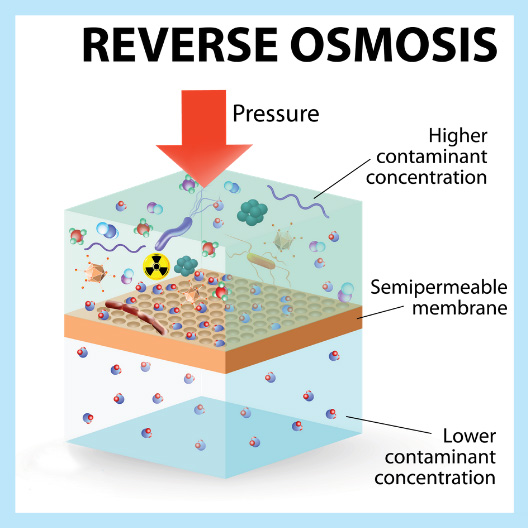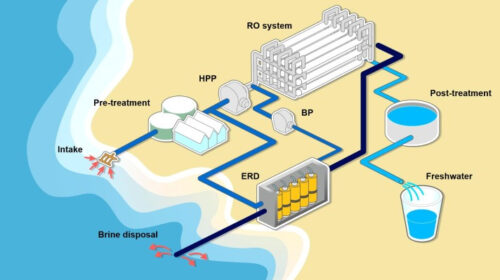BEHIND THE TECHNOLOGY OF SEAWATER REVERSE OSMOSIS DESALINATION PLANT
Discover how to find best quality and affordable price for seawater reverse osmosis desalination plant from China.
Imagine you pay a lot of money to SWRO water purification plant and you are never satisfied pure water quality, high electric cost and high maintenance cost.
Imagine you find a best supplier from China and you pay half cost of European or USA suppliers for the whole system accordingly.
Guangzhou Chunke Environmental Technology Co.Ltd. with 15 years’ experience, over +500 projects in over +100 countries. We are using best brand in seawater reverse osmosis desalination plant, for example Danfoss, Toray, Dow Filmtec, Schneider, Siemens…etc. Also we can design Sea water reverse osmosis plant with high quality Chinese brand for example, Vontron, Runxin, CNP…etc.

Does reverse osmosis work on seawater?
First, we explain how reverse osmosis system works. Reverse Osmosis (RO) is a water treatment process that removes contaminants from water by using pressure to force water molecules through a semipermeable membrane. So, during this process, the contaminants are filtered out and flushed away, leaving clean, pure water. And reverse osmosis can work up to TDS 50.000-60.000ppm level. Seawater’s TDS (total dissolved solids) level is between 20.000 to 45.000ppm accordingly.
So that reverse osmosis system is the best choice to remove salt from sea water.
Can reverse osmosis desalinate seawater?
Seawater Reverse Osmosis Desalination Plant can remove salt up to 100 – 200ppm. So, it means that, you can gain fresh water with 200ppm TDS level. Here, if you check your city water (tap water), you can see that its TDS level is about 200-300ppm.
Hence, when you use SWRO desalination system, you can get fresh water. If you are in an industry which needs ultra-pure water, double pass reverse osmosis system can reduce the TDS 2-4ppm level.
How can reverse osmosis be used to obtain fresh water from seawater?
Here, we explain seawater reverse osmosis desalination plant with flow chart.

Seawater firstly passes pretreatment unit, it includes media filter tanks, chemical dosing, cartridge filter housing. Second, pretreated water passes seawater swro membranes and they block salt, bacteria and viruses, after membrane process you gain fresh water.

How does a seawater desalination plant work?
So, to understand how does it work, it is better to watch our video about how does reverse osmosis membrane work?
What is the difference between reverse osmosis and desalination?
We have got this question many times from customers. After discussing with customer, mostly we understand that people confused with desalination and distillation. Because reverse osmosis is a desalination process. So, maybe you do not taste salt in your water but a lot of minerals like Ca, Mg, Na, K… etc. are a kind of salt and reverse osmosis remove most of them from water.
Hence, distillation is a process to separate liquids by using their different boiling points.
Advantages and disadvantages of seawater reverse osmosis desalination plants
The advantage of desalination plants
- Seawater reverse osmosis systemsremove dissolved salts and other minerals from seawater and turn it to drinking water. It provides a solution for areas that have limited resources of fresh water and a reliable alternative source of water in times of severe drought.
- Desalination also produces water that you can use for irrigation. So it is great for arid regions or in many areas around the world where there is no enough fresh water.
- Positive improvements in the performance of RO membranes have greatly enhanced the use of seawater desalination. Since it becomes an alternative for fresh and potable water production.
- Seawater desalination systems have been in use over 10 years now, and its method is effective in creating fresh sources of drinking high quality water that is safe and reliable.
- As the freshwater supply on our world has limit, we should preserve its resources by utilizing the method of desalination to eliminate water shortage crisis that the world might face.
- We have plenty amount of seawater to produce freshwater through desalination, so even in times of droughts, there will be sufficient access to fresh water supply.
- Unlike other solutions that heavily rely on uncontrollable factors like rain or snowfall, seawater desalination systems do not rely on anything other than the ocean or seawater.
- Desalination plants usually locate away from residential areas and some of them are located in industrial areas, so they don’t put residential areas at risk.
- Desalination plants can reduce the pressure on freshwater sources. Seeing the ocean as a water supply, might help with increase the awareness in protecting our oceans.
The disadvantage of desalination plants
- Reverse osmosis Desalination plants consume more electrical power compare to normal reverse osmosis system.
- Desalination plants investment cost because of high pressure pumps and special membranes mpre expensive than standard reverse osmosis system.
- Desalination plant produces higher TDS concentrate water compare to standard reverse osmosis systems.
Can you drink ocean water or seawater if you boil it?
Unfortunately, no, if you boil seawater, you get more salty water. Because, when water evaporate, dissolved salt is still in water.
Hence, to get fresh water from seawater, you have to use reverse osmosis system or evaporation + condensation process. It means that first you have to boil water and get water vapor, then condense this vapor on cold surface and get fresh water.
Because of energy cost and huge investment, evaporation and condensation process just use in brine water treatment, where water TDS is higher than 60.000ppm.
What is the largest desalination station in world?
At al-Jubail, the world’s largest desalination plant which makes more than 1.4 million cubic metres of water daily, treated waste brine plumes back into the Arabian Gulf accordingly.
What is the best desalination company to invest in?
Here, we are giving 10 best seawater desalination system producers in the world.
- Veolia Environnement S.A.
- Consolidated Water Co
- Energy Recovery Inc
- Acciona SA
- ACWA Power Co
- SafBon Water Service
- Abengoa, S.A.
- Hitachi Zosen Corporation
- Guangzhou Chunke Environmetal Technology Co.Ltd.
How many desalination plants are in the US?
The United States currently has over 1,400 installed desalination plants with the majority being used to desalt brackish groundwater.
Which country invented desalination?
Alexander Zarchin (1897–1988) was a Ukrainian-Israeli chemist and inventor. He is most noted for inventing a process of sea water desalination.
Does Israel have a desalination plant?
Today some 585 million m3 of water per year are desalinated in the State of Israel. Meanwhile, the Soreq plant provides 150 million m3 per year, the Hadera plant 127 million, the Ashkelon plant 118 million, the Palmachim plant 90 million, and the Ashdod plant 100 million.
What is SWRO desalination?
Sea water reverse osmosis (SWRO) is a reverse osmosis desalination membrane process that has been commercially used since the early 1970s. So, its first practical use was demonstrated by Sidney Loeb and Srinivasan Sourirajan from UCLA in Coalinga, California.
What is the problem with desalination reverse osmosis?
Seawater reverse osmosis (SWRO) desalination has some environmental impacts associated with the construction and operation of intake systems and the disposal of concentrate. The primary impact of conventional open-ocean intake systems is the impingement and entrainment of marine organisms. So, you can use zero liquid discharge system to get solid waste.
